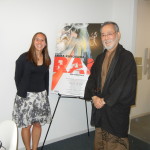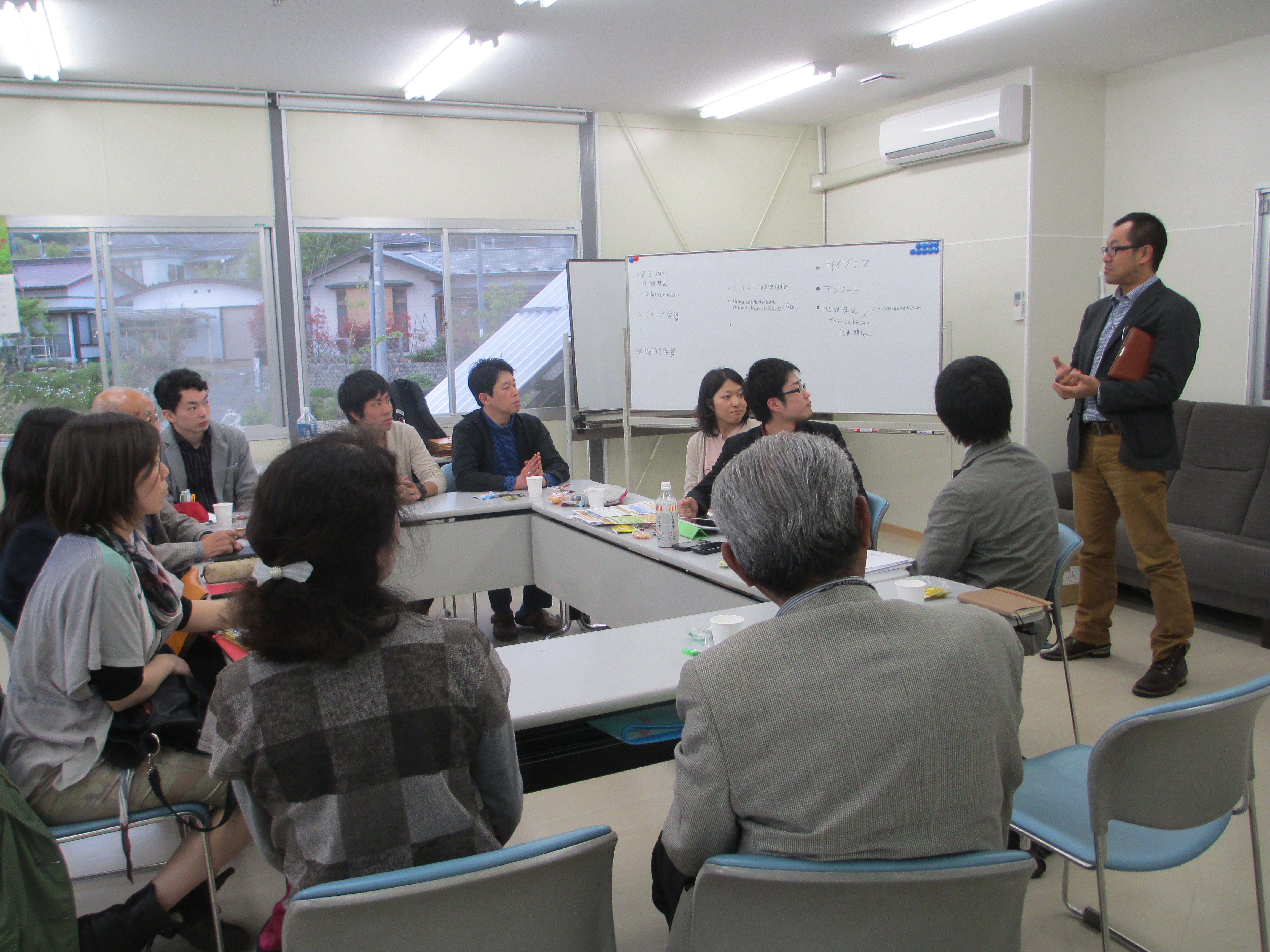WIT Life #263: Tohoku Earthquake/Tsunami 3-year anniversary
WIT Life is a periodic series written by professional Writer/Interpreter/Translator Stacy Smith (Kumamoto-ken CIR, 2000-03). She starts her day by watching Fujisankei’s newscast in Japanese, and here she shares some of the interesting tidbits and trends along with her own observations.
Today in Japan (where it is already March 11) marks three years since the earthquake/tsunami hit the Tohoku region. In a nationally televised news conference to commemorate the anniversary, Prime Minister Abe talked about the children who have lived their whole lives only knowing their home as a disaster-stricken area, saying he wanted to invite as many of them as possible to the 2020 Olympics as a “symbol of reconstruction.” Over the last three years recovery has taken place, though not at a pace as fast as some would like. The news this morning reported that out of the “reconstruction housing” that is to be built in the affected prefectures of Iwate, Miyagi and Fukushima, only 3% has been completed. Many of the over 267,000 evacuees are living in temporary housing that has become more permanent than temporary.
In terms of what can be done to help, many speak of the necessity of implementing not only one-time events, but sustainable activities that will serve as a source of both economic and psychological sustenance. Experts on a recent Japanese political talk show agreed that the goal should not be returning the region to what it once was, some even lamenting oft-used terms such as “reconstruction assistance” and “affected area.” They claim that these ways of thinking are not a basis for moving forward, but looking back. They encourage those who want to help to focus their efforts on Read More
Donate for Tohoku on March 11 and Make Your Support TWICE As Effective!
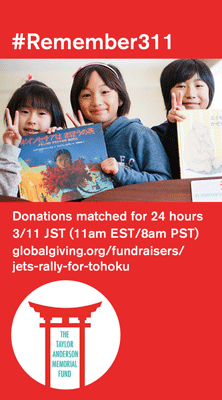 3/11 Update: FYI, the 24 hour deadline for Global Giving to match donations to the Taylor Anderson Memorial Fund and other 3/11 initiatives has been lifted, and they will continue to match JET contributions until matching funds run out. So JETs/alums can continue to double their donations!
3/11 Update: FYI, the 24 hour deadline for Global Giving to match donations to the Taylor Anderson Memorial Fund and other 3/11 initiatives has been lifted, and they will continue to match JET contributions until matching funds run out. So JETs/alums can continue to double their donations!
*Link to the Global Giving Matching Page: http://www.globalgiving.org/leaderboards/japan-matching-2014/ to see how much various groups are raising.
*Link to the JETAA USA Event Page: https://www.facebook.com/jetaausa
*The link to donate has been added!
Put this on your calendar!
JETAA USA is supporting the Taylor Anderson Memorial Foundation for a 24 hour donation drive that starts when the clock strikes midnight in Japan on March 11. And GlobalGiving has offered to match these donations.
This is a great opportunity to show our ongoing support for Tohoku by going to the Global Giving website on March 11th to make a donation during the matching grant period.
Online donation drive
Donation website: http://www.globalgiving.org/fundraisers/jets-rally-for-tohoku/
Starts: 12:00 midnight Japan time on 3/11 (11 am EST, March 10; 8 am PST, etc)
Ends: 11:59 p.m. Japan time on 3/11 (10:59 am EST on March 10)
Background
Three years have passed since the Great East Japan Earthquake and Tsunami and the devastation in Tohoku has largely faded from the news. However, so much remains to be done for the survivors and TAMF has been partnering with a number of organizations in Japan to provide relief and help the people of Tohoku build a strong and vibrant future.
Smile Together IshinomakiTAMF has provided funding to the following projects:
-
Living Dreams: Tohoku Kids Project
-
Hope for Tomorrow
-
JET Micro Grants
-
Taylor Anderson Reading Corners
-
Taylor Sendai YMCA Scholarships
-
Exchange Programs
For more information on TAMF, please go to http://www.taylorandersonmemorialfund.org/, their Facebook page at https://www.facebook.com/taylorandersonmemorialfund, or watch the NHK interview with Jeanne and Andy at https://vimeo.com/86637051.
JETAA USA is proud to partner with TAMF to carry on the support JETs and JET alumni have shown for Japan and the people of Tohoku ever since March 2011.
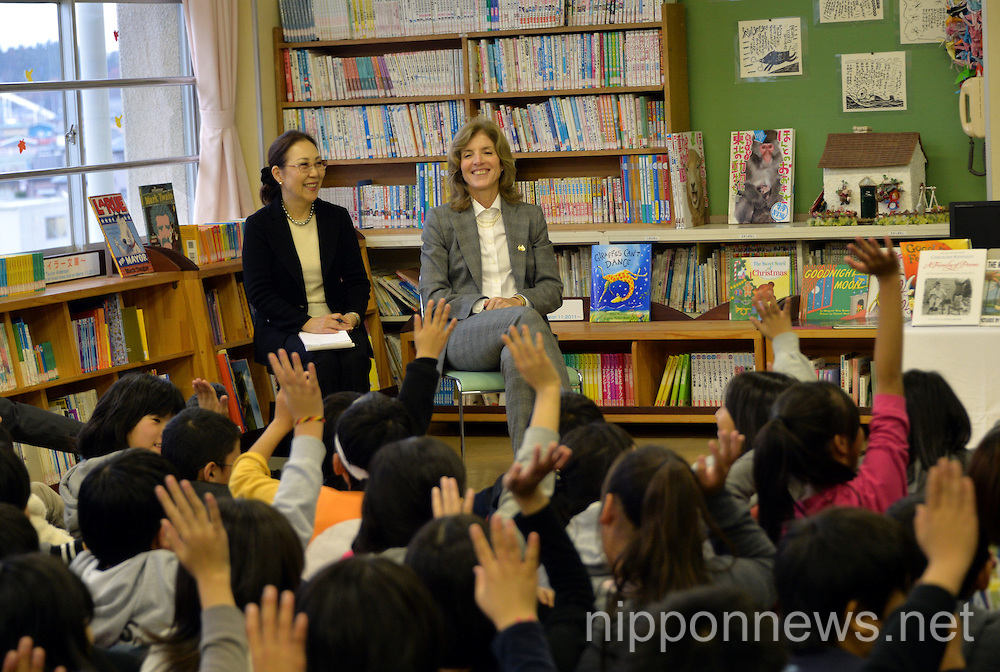
Details:
All donations up to $1,000 per individual donor made to the Taylor Anderson Memorial Fund on March 11th Japan time will be matched by Global Giving through their Japan Match Global Giving program. (Global Giving will charge a 15% facilitation fee to cover their costs, which donors may choose to cover if they wish so that their full donation amount goes to TAMF. See the page for details.)
We are also very happy to see Ambassador Kennedy giving her backing to their mission, as well. For coverage of her recent trip to Ishinomaki and visit to Mangokuura Elementary School, where Taylor taught, please check out the article at http://ajw.asahi.com/article/0311disaster/recovery/AJ201311250099.
JQ Magazine: Staying On—JETs in Fukushima Share Their Stories
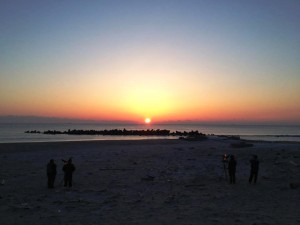
Sunrise over Iwaki: A local pre-dawn commemorative service took place on March 8, 2014, which included taiko performances and ended with the sunrise over the beach near Shinmaikohama Park. (Alexandrea “Xan” Wetherall)
By Eden Law (Fukushima-ken, 2010-11) for JQ magazine. Eden lived and worked in the core city of Iwaki on JET, and he is a current committee member of JETAA NSW, based in Sydney, Australia.
Introduction
It’s been three years since the Great East Japan Earthquake of 2011. While the rest of the world, and arguably, the rest of Japan, has moved on, communities all along the east and north coast continue to endure and deal with the continuing legacy and consequences of that event, especially those displaced from the exclusion zone around TEPCO’s Daiichi plant.
The JET Programme continues to operate, with the government previously announcing plans to double the number of participants over three years. JETs continue to live and work in Tohoku, including JETs who were there before the earthquake, joined later by those placed after 2011. This article will examine the experiences and viewpoints of JETs who continue to work and live in Tohoku, in particular, those living in Iwaki, Fukushima, a city just past the the southern edge of the nuclear exclusion zone. Three years on, they will relate what they’ve seen and observed in their neighbourhood and the city. In addition, the viewpoints of two local Japanese residents will also be included, one from a retired member of a suburb in which evacuees have been housed; and a Japanese English teacher and mother of two.
Before the earthquake, Iwaki was one of the biggest rural cities in Fukushima, with a thriving fishing and farming industry, popular with tourists who come for its natural beauty and well-known beaches. A region rich in history from the Nara period (and prehistory, with its own dinosaur and fossil museums), it also has a famous theme park called the Spa Resort Hawaiians (made famous by the 2006 award-winning film Hula Girls) as well as the Aquamarine Fukushima aquarium. A mere 2.5 hours away from Tokyo by express train, it also supports a large JET community, ideal for those wanting to experience a rural pace with easy access to the bright lights of Tokyo. As a JET placement, it was arguably one of the best places to be.
JQ Magazine: JQ&A with Photographer Wei Yuet Wong on ‘The Fukushima Project’
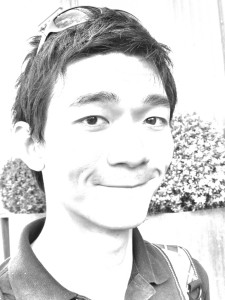
“Though people have told me no one wants to see disaster photos anymore, I think it’s a good reminder because it’s barely three years, and already people are forgetting. Not only outside Japan, but within Japan itself, people are forgetting. It’s true that people need to move on and rebuild their lives, but there’s still so much more work to be done in Tohoku.” (Courtesy of Wei Yuet Wong)
By Nathalie Ng (Shizuoka-ken, 2010-11) For JQ magazine. A member of JETAA Singapore, Nathalie was an inaka JET and her time in Japan has taught her to appreciate the flowers by the roadside and how to snowboard.
Wei Yuet Wong (Nagano-ken, 2008-10) left his home in Singapore to join JET following a summer homestay in Hiroshima. He went there because of the history as he’d learnt about the devastation during World War II, and he was particularly interested in seeing how the city had progressed since then. The relationship formed with his homestay family inspired him to join JET.
Assigned to three different schools in Ueda City, during his first few months he was often left feeling clueless and dependent on his supervisor due to the language barrier and the office hierarchy, but he soon got better at it by keeping an open mind and adapting. He is particularly proud that he was able to inspire in his students that they didn’t have to speak English with an American accent to be understood, and this has helped them to be more confident, speaking out during and outside of classes. (In fact, one of Wong’s former students even visited him and his family during the Chinese New Year.)
Since returning from Japan Wong has been working as a corporate warrior, but since last year he has finally taken the leap to pursue his photography interests. His work is now on display in a new exhibition called The Fukushima Project, which runs through 14th February at Select Books in Singapore on 51 Armenian Street. Through special postcards available for sale, visitors can write messages to the people of Hisanohama in Iwaki, which will then be collected and sent to them to let them know that their story has not been forgotten.
In this exclusive interview, JQ spoke with Wong about his visits to Fukushima before and after the 2011 Tohoku earthquake and tsunami, and the relationships he’s made with the locals through his numerous community activities.
You were posted to Nagano-ken and you lived there before the quake happened. What was your motivation for this exhibition?
I felt awed and hopeless when I first looked at the videos of the earthquake, perhaps like so many people around the world. Then why Fukushima? I think there may be three explanations. One, I first visited Fukushima in 2009 to visit friends, so I got to see Fukushima before the disaster. It was quite a different place.
Two, I have friends in Fukushima, and they live in Koriyama city, about 45 km away from the Fukushima No. 1 nuclear power plant. I was concerned about them. I was curious to know how they felt on the day of the earthquake, and then during the subsequent confusion about the nuclear power plant. I also wanted to see how they are doing when most other parts of the world, and Japan, starts forgetting about them.
Lastly, I wanted to experience how it would be like to venture into the disaster zone. I have a need to see things for myself. To touch the soil. Walk on the sand. Smell the salty air on the Japanese east coast, and try to imagine how people felt that day.
Why did you choose this particular town of Hisanohama?
It was by chance that I discovered this town. It’s quite a story, one thing leading to another, with some fortunate chance encounters. But, the best summary is: I met a friend at Koriyama Station to listen to her account, and her experiences. After that I wanted to visit the coast, so she told me that Iwaki is where I should go. With my ticket bought, I hopped on the bus for the 1.5 hour journey to Iwaki. Once at Iwaki, I went to the local tourist office, and asked for directions to the coast. The person at the office looked quite surprised, and she pulled out a map, studied it for a moment, and said, “Maybe you shouldn’t go. We used to have nice beaches, shrines, and attractions. But now, nani mo nai (there’s nothing).” I was not put off, and she finally realised that I would still go no matter what, and she suggested why don’t I go to Hisanohama, where I can have a nice walk, and just look around. So, there I went.
In the international media, most people know about Kesennuma, Rikuzentakata and Minamisoma, but Hisanohama remains unknown. So, I think it’s nice that I visited Hisanohama. It’s a town just 31 km south of the Fukushima No. 1 nuclear power plant, along the Pacific Coast, and has suffered great damage in the tsunami.
JQ Magazine: Tohoku Projects—The TOMODACHI Initiative
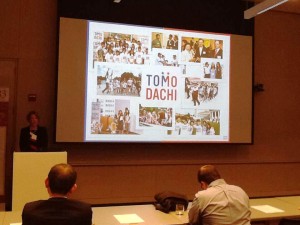
Suzanne Basalla, left, presents The TOMODACHI Generation: Investing in the NEXT Generation of U.S – Japan Relations, Chicago, Oct. 11, 2013. (Sheila Burt)
By Sheila Burt (Toyama-ken, 2010-12) for JQ magazine. As part of an occasional series, Sheila is profiling individuals who are or were in some way involved with rebuilding efforts in the Tohoku region. Her first post was on the writing project 3,000 Letters to Japan. After JET, Burt spent an additional year in Japan working at a private school and translation company. She recently returned to the Chicago area. Read more of her reporting at her blog, Stories from the Inaka.
Having been posted in Tokyo during the disastrous March 11 earthquake and tsunami of 2011, diplomat Suzanne Basalla saw firsthand how quickly Japan changed in a matter of seconds.
As senior advisor to former Ambassador John V. Roos in the Embassy of the United States in Tokyo, Basalla had been living in Japan since March 2010, advising Roos on several economic and foreign policy matters. A few months after 3/11, Basalla visited Tohoku and started thinking of ways to encourage redevelopment in the stricken area, “trying to do what we [could] to create hope and support,” she recalled. Although her post with the embassy ended in March 2012, she realized she wasn’t ready to go back to the Pentagon.
Instead, Basalla and a team of others pooled their efforts to create the TOMODACHI Initiative, a public-private partnership established in the wake of 3/11 with the U.S.-Japan Council in Washington. TOMODACHI helps coordinate educational, business and cultural exchange programs for Japanese youth, particularly students in Tohoku, where development opportunities are still few and far between. Presenting at a Japan American Society of Chicago event last October, Basalla referred to TOMODACHI as “an incredibly important initiative…with a path-breaking paradigm.”
“Part of leadership is getting to know yourself,” said Basalla, who now serves as executive vice president of the U.S.-Japan Council. “TOMODACHI’s initiative is to inspire and empower young Japanese and Americans by giving them experience, skills and confidence to achieve their dreams and contribute to a better world.”
“Reunion” – Film Review from Australia’s 17th Japanese Film Festival
Australia’s 17th Japanese Film Festival is soon embarking on its last city tour in Melbourne, the capital of the southern state of Victoria, after being shown around Australia in the first ever national film festival administered by the Japan Foundation. Eden Law (Fukushima-ken ALT 2010-2011, current JETAA NSW committee member) got to see some of what’s on offer during its recent run in Sydney. This one’s for you, Melbournites! Don’t say we don’t do anything for you south of the border.
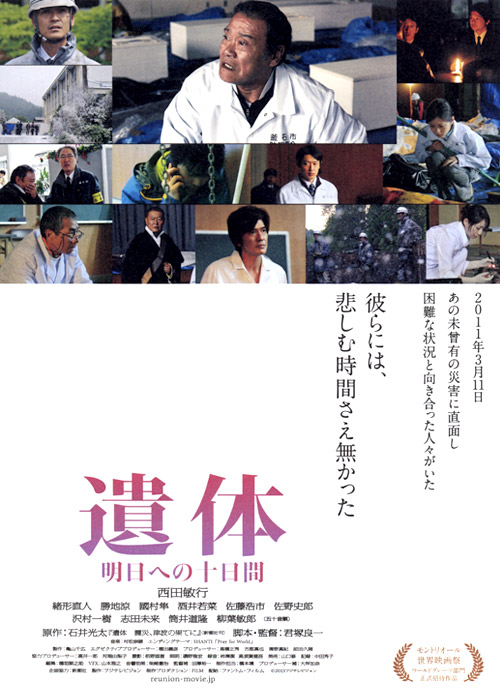
If you can’t feel anything watching this, you are probably dead inside.
It has been almost three years since the disaster that devastated the north of Japan. There have since been a handful of films on the event, on the nation and it’s people as they resolutely look forward to “revival” and reconstruction. However, few of those films, I suspect, would have dealt quite so starkly and closely on the subject of death quite like “Reunion”.
“Reunion” is a dramatization of Itai: Shinsai, Tsunami no Hate ni (遺体―震災、津波の果てに?, “The Bodies at the End of the Earthquake and Tsunami”), a reportage of the events by Kota Ishii in the days immediately following the earthquake and tsunami of March 11. A brief snapshot of the normal, mundane lives around town in the beginning, contrasts sharply the aftermath, showing how unprepared and ill-equipped the small town’s public servants were, as bodies kept coming into the temporary morgue set up in the old high school gymnasium, and distraught relatives plead for information and support. Horrified by the disorganization and haphazard treatment of the dead, Aiba (played by Toshiyuki Nishida), a retired funeral home director, volunteers to oversee the proper administration of the morgue. He shows the exhausted and numbed workers how to massage limbs stiffened by rigor mortis until they became pliant again for proper positioning, and how to counsel and deal with the grieving and traumatized people who come to identify the deceased. And slowly, people carry on with their jobs, because there is very little other choice.
This will be the most heart-breaking film you’ll ever watch this year. I’ve never cried at the movies before (if there’s anybody watching), but looks like there’s the first time for everything. While the subject matter itself is undeniably powerful and emotional, “Reunion” is actually quite simple, a recounting of the events and the personal tragedies of those who survived. Music is used sparingly in this film, the silence heightening the solemnity and noises that included the constant squelching of the mud-logged boots and the sobs of the bereaved, background sounds as described in the book. Director Ryoichi Kimizuka makes sure that the deceased is an all-pervasive presence, as the cast of characters work with them and around them, uncovering their blackened swollen faces, identifying them and saying prayers for their souls. Thanks to Aiba’s character, not only are the workers brought around to empathise with the dead, as their names and personal stories are revealed, but the audience also becomes involved. Little wonder then, that at many events where this film has been screened, audiences have been emotionally devastated.
In this film where multiple stories and tragedies play out, the cast work marvellously well together. There are very little histrionics or hysteria, just numbed helplessness, as many at first wander confusedly about before being given direction by Aiba. Performances are muted and restrained, which make the break-down moments even more heart-wrenching, for everyone has their trigger, be it the discovery of a loved one’s body while carrying out work, or the tragedy of a young child, unclaimed by any surviving relatives. There are no questions of morality, no “why did this happen to us”, soul-searching, condemnation or religious debate to be had that can be adequate. From Aiba’s point of view however, the answer is to never forget one’s humanity, which can be even more precious than food, in order to survive the unrelenting horror and sorrow of the situation. And that in the end, ultimately provides a glimmer of positivity in this film, as well as in life.
Reunion (Itai: Shinsai, Tsunami no Hate ni) by Ryoichi Kimizuka, released in Japan February 23 2013, starring Toshiyuki Nishida, Naoto Ogata, Ryo Katsuji, Jun Kunimura, Wakana Sakai, Tsuneo Aiba, Kenichi Domon, Yuta Oikawa, Yoshito Shibata, Takae Oshita, Koichi Sato, Shiro Sano, Ikki Sawamura, Mirai Shida, Michitaka Tsutsui, Michio Shimoizumi, Takeshi Yamaguchi, Nobutsugu Matsuda, Yuko Terui, Daisuke Hiraga, Toshiro Yanagiba
JQ Magazine: JETAA USA Earthquake Relief Fund Aids Recovery
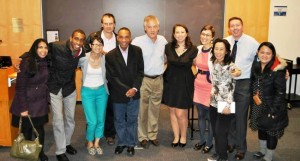
Taylor Anderson Memorial Fund founder Andy Anderson (center) with members of the JET Alumni Association of New York at Columbia University, Oct. 30, 2013. (Courtesy of JETAA New York)
By C-M Daeley (Saga-ken, 2008-2011) for JQ magazine. C-M is a poet, rap lyricist, and travel enthusiast currently working as an English teacher in Tokyo. For a look at some of his other writing, poetry and lyrics, check out his blog at http://spikedaeley.wordpress.com.
With today’s 24-hour global news cycle, it is sometimes difficult to keep even the most severe events in public memory. The Great East Japan Earthquake that struck on March 11, 2011 has not received much recent coverage in global news, but the issues faced by those still rebuilding remain monumental. Fortunately, there has been significant international aid from a number of sources, one of which is the JETAA USA Earthquake Relief Fund. This grant has raised almost USD $90,000 and has been used to provide seed funding to assist grassroots programs in areas severely impacted by the earthquake.
Due to the complex nature of fund allocation, this article will focus mainly on projects and programs directly supported through JETAA funds. However, it is significant to note that the Earthquake Relief Fund was only one of several avenues used to bring aid to the region and that, to date, roughly $500,000 has been raised through JET-affiliated groups and organizations worldwide. Jim Gannon (Ehime-Ken, 1992-94), current executive director at the Japan Center for International Exchange in New York, and Jessyca Livingston (Hokkaido, 2003-06), one of the three JETAA USA Country Representatives serving during the immediate aftermath and current JET Program coordinator at the Consulate-General of Japan in Denver, spoke about some of the initiatives the Earthquake Relief Fund has helped support.
“It is very difficult to give a concise yet comprehensive picture of what the JETAA funds have done,” Gannon explained. “The best way to describe it is that they have played a catalytic role in supporting some key projects in the early stage that have been supported by a range of others in more generous fashion once they proved their merits. JETAA cannot take full credit for all of the successes, but it did play an important role in getting things moving.” He also noted, “The real heroes are these incredible people from Tohoku who have championed these projects, the inspirational young people who have relocated to Tohoku to help operate them, and those who have been shuttling back and forth from Tokyo and elsewhere to help formulate and drive these initiatives.”
After a national discussion and several rounds of voting in each of JETAA USA’s 19 chapters, a final decision was made about how the fund should be allocated. “In the end, it was very obvious that chapters found it important to support education-related efforts in those areas most affected,” Livingston said.
JQ Magazine: 2013 JETAA National Conference in Minneapolis Recap
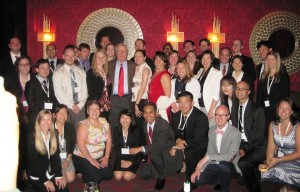
JETAA USA National Conference participants in Minneapolis with former Vice President of the United States Walter Mondale, Sept. 26, 2013. (Courtesy of Yeu-Li Huang)
By Yeu-Li Huang (Yamanashi-ken, 2007-2010) for JQ magazine. Yeu-Li is the current chapter secretary of the JET Alumni Association of the Southeast (JETAASE).
MINNEAPOLIS, Minn. – The JET Alumni Association of Minnesota (JETAAMN) hosted this year’s USA National Conference from Sept. 26-29 with assistance from the Ministry of Foreign Affairs (MOFA) and the Council of Local Authorities for International Relations (CLAIR). Attendees included delegates from all 19 JETAA USA chapters, as well as representatives from CLAIR, MOFA, and the Consulate General of Japan at Chicago.
Each national conference spotlights particular challenges facing the JETAA community. This year was no different, as critical topics included continuation of the JETAA national initiatives, common issues facing JETAA chapters, membership outreach, and collaboration between JETAA chapters and other Japan-related organizations.
Thursday, Sept. 26
The conference got underway with an evening reception at the restaurant Crave, featuring former Vice President of the United States Walter Mondale as a special guest. A native Minnesotan, Mondale was also the U.S. ambassador to Japan from 1993-96. In his speech, Mr. Mondale praised the work that the JET Program has done in building personal relationships between Japan and the U.S., and called for “JETers” to continue fostering those ties.
Update 09.30.13: “Live Your Dream: The Taylor Anderson Story”
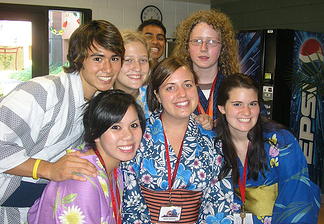 Thanks to Taylor’s father Andy Anderson for sharing the below update:
Thanks to Taylor’s father Andy Anderson for sharing the below update:
Toho-Towa Company, LTD (Godzilla, etc.) is promoting Taylor’s film throughout Japan with City halls, other NPO’s, Boards of Education, JETs, etc. JETs are good candidates to organize screenings as part of their community relations work. Towa has posted information about this at www.youtube.com/watch?v=cjUvhwX-jDQ.
Part of the proceeds from screenings will go to the Taylor Anderson Memorial Fund which is being set up as a Japanese NPO. Ambassador Fujisaki has agreed to be on the board and is helping us recruit other board members. We’re working on a new website for the fund as well. Towa would also like to have someone (such as JETs, former JETs, those associated with Taylor’s fund) speak at each screening.
Towa will launch this effort at the Yamagata film festival on 10/12/2013 www.yidff.jp/2013/program/13p7-e.html (Regge and some Taylor fund people will be there) and in Tokyo October 15th for potential screening hosts. Screening dates will start to be known about that time and we’ll keep them updated on www.thetaylorandersonstory.com and www.facebook.com/LiveYourDreamTheTaylorAndersonStory.
Australian JETAA chapters recognized for Tohoku revitalization efforts at CLAIR Sister Cities Forum
Via the JETAA New South Wales (Australia) website: http://www.jetaansw.org/jets-recognised-in-award/
The work and support by members and participants of the JET Programme and JETAA chapters for the revitalisation of Tohoku after the 2011 earthquake, was formally recognised in an award presentation at the 2013 CLAIR Sister Cities Forum.
Presented by Alderman William (Bill) Willson, President of Sister Cities Australia, the award was received by Ben Trumbell, president of the NSW chapter of JETAA. It was given in the presence of Ms Yoko Kimura, Chairperson of the Board of Directors of CLAIR (Council of Local Authorities for International Relations) and Dr Masahiro Kohara, Consul-General of Japan in Sydney.
“The award was presented to me as the closest president representative of JETAA. In my acceptance speech I outlined the importance of the JET Programme and the number of participants and members of JETAA, along with our objectives and a summary of our activities,” Ben said. “Australia has been fantastic in their response to the events in Tohoku. The Victorian JETAA chapter for example did fantastic work with the Big Bento Lunch initiative which raised more than $15,000 across our chapters.” The NSW chapter’s achievements should also be noted for raising awareness, starting with an exhibition of Fukushima school children’s letters at the 2011 Sydney Japan Festival, which lead to the visit of Councillor Alan de Surf of a junior high school in the city of Iwaki, Fukushima.
The 2013 CLAIR Sister Cities Forum marked the 50th Anniversary of the sister city relationship between Lismore, NSW and Yamato Takada in Nara, Japan. This was the first ever sister city relationship between Australia and Japan and was instrumental in initiating the close post-war relationship that exists between the two countries today, thanks to the efforts of Father Paul Glynn who began the first efforts in forging this link.
The subject of sister cities will continued to be explored by JETAA in the annual JETAA conference to be held later this year in Brisbane. Ben states that he hopes to share ideas and case studies including the Lismore-Yamato Takada story at the conference, as well as looking forward to sharing the award with the other chapters and presenting the certificate to the Australian country representative.
WIT Life #242: End of Japan Cuts 2013
WIT Life is a periodic series written by professional Writer/Interpreter/Translator Stacy Smith (Kumamoto-ken CIR, 2000-03). She starts her day by watching Fujisankei’s newscast in Japanese, and here she shares some of the interesting tidbits and trends along with her own observations.
Yesterday Japan Cuts 2013 came to a successful close, with a jam-packed schedule of four films in a row. I only caught the middle two, Japan’s Tragedy and Dearest, both of which deal with the theme of death (like the earlier screened I’M FLASH, and they all do this deftly in their own unique ways). Japan’s Tragedy stars the amazing Tatsuya Nakadai, an 80-year old actor who I had the honor to interpret for at an event last month at the Museum of the Modern Image when his film Ran (directed by Akira Kurosawa) was featured and he participated in a Q&A following the film.
Nakadai’s downtrodden character in Japan’s Tragedy is in direct contrast to his genkiness in real life. The father he plays has recently lost his wife and has also been diagnosed with lung cancer on the morning of 3/11. After going through one operation he decides that he doesn’t want any more treatment, and furthermore that he will board himself up in his room and die beside the altar for his late wife. His son who is living with him since leaving his wife and daughter, as well as his job, is surviving on his father’s pension and taking care of him. Unsure of how to react to his father’s pronouncement, he initially tries to Read More
Justin’s Japan: Nippon in New York — JAPAN CUTS, Lincoln Center and Aerosmith Rock the Rising Sun
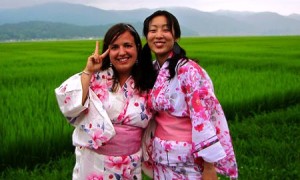
Live Your Dream: The Taylor Anderson Story premieres at Japan Society in New York July 16 as part of their annual JAPAN CUTS summer film festival. (© 2012 Global Film Network. All rights reserved.)
By JQ magazine editor Justin Tedaldi (CIR Kobe-shi, 2001-02) for Examiner.com. Visit his Japanese culture page here for related stories.
After you’ve seen the outdoor fireworks, enjoy some summer events in the cool indoors, whether it’s catching one of 20 films in Japan Society‘s annual festival or firing up the newest home video release from Aerosmith that documents the band’s triumphant return to Japan following the 2011 Tohoku earthquake and tsunami.
This month’s highlights include:
July 11-21
Japan Society, 333 East 47th Street
$12 general/$9 Japan Society members, seniors and students. I’M FLASH! prices $15 general/$12 Japan Society members
Now in its seventh season, with 10 days of screenings and over 20 titles, JAPAN CUTS 2013 presents the roughest, sharpest, and smoothest of today’s cutting-edge Japanese film scene, encompassing bigger-than-life blockbusters, high-concept art house titles, moving and provoking documentaries, delirious rom-coms, refined melodramas and a handful of UFOs—unidentified film objects. Dovetailing with the New York Asian Film Festival, this year’s highlights include the smash-hit samurai blockbuster Rurouni Kenshin; Eiki Takahashi’s absorbing glimpse into the glitzy world of Japanese pop music, DOCUMENTARY OF AKB48: Show Must Go On; the winner of the 36th Japan Academy Prize for Best Picture and Best Director, The Kirishima Thing; plus the new film from the wildly prolific auteur Takashi Miike, the psycho killer-teacher horror film Lesson of the Evil, a return to the director’s signature gonzo schlockmeister approach.
July 18-20
Lincoln Center Festival presents Matsukaze
Gerald W. Lynch Theater, 524 West 59th Street
$35-$75
Harmonious sounds and haunting songs converge in this exquisite production of Matsukaze (Japanese for “wind in the pines”). Inspired by a popular 15th-century play crafted in part by Noh master Zeami, the opera features a spare, ethereal score by Toshio Hosokawa, one of Japan’s most prominent living composers of contemporary classical music. Matsukaze tells the story of two sisters, two lingering spirits, who wander the porous boundary of the living and the dead in hopes of being freed from a former mortal lover. John Kennedy conducts the Talea Ensemble and a cast of soloists and chorus in this arresting, dreamlike performance set in the shadowy place where the wall between the ephemeral and the corporeal disappears. Sung in German with English supertitles.
For the complete story, click here.
BBC: Fukushima schools rebuild after disaster
It would be interesting to hear any comments or perspectives from Fukushima JETs or alums about what they describe in this BBC article. (Thanks to Eden Law of JETAA New South Wales for posting it to their Facebook group.)
Fukushima’s Schools Rebuild After Disaster
“How do you re-build an education system destroyed by a disaster? The OECD’s Andreas Schleicher describes the efforts in Japan, two years after the nuclear accident in Fukushima.”
Link to full article: http://www.bbc.co.uk/news/business-21576192
Welcome to JET Talks, by JETAADC – Live Your Dream Q&A
JET Talks is a brand new speaker series organized by the JET Program Alumni Association of Washington, DC. JET Talks is modeled after the TED Talks concept and will feature dynamic and interesting speakers with the goal of inspiring innovative ideas and conversations on Japan-related themes. Although JET Talks audio files will be accessible via the Let’s Talk Japan podcast subscription feed, the two are separate entities. However, our goals are the same – to get people talking and thinking about Japan.
Shauna Tischler, came up with the idea of JET Talks and currently serves as JETAADC’s Thought Leadership Chair. From 2000-2003, Shauna worked as an Assistant Language Teacher on the JET Program in Gifu Prefecture. Special recognition is also owed to Leigh Ann Mastrini, the current President of JETAADC, and the Japan Information and Cultural Center of Washington, DC, for hosting the first JET Talks event.
Regular listeners of the Let’s Talk Japan podcast will recall that in Episode 11, host Nick Harling spoke with Regge Life about making the film Live Your Dream, chronicling the lives of JET Program participants Taylor Anderson and Montgomery Dickson, who passed away in the March 11, 2011 Tohoku earthquake and tsunami.
Regge was recently in Washington, DC, along with Taylor’s father, Andy Anderson, and Montgomery’s sister, Shelly Frederickson, to speak at the first JET Talks event – a screening and panel discussion of the film Live Your Dream. More than 120 guests were in attendance and the event was a huge success.
For anyone who has not seen Live Your Dream, I encourage you to listen to Let’s Talk Japan episode 11, as it provide a good overview of the film.
In this JET Talks, you will first hear introductory remarks from the event organizers and panelists, followed by the panel discussion, which followed the screening.
You can listen to this first installment of JET Talks by subscribing to the Let’s Talk Japan podcast in iTunes or by clicking HERE.
JETAA USA Disaster Relief Fund Update – 06.01.13
Jim Gannon (Ehime-ken, 1992-94), Executive Director of the Japan Center for International Exchange (JCIE/USA) and a member of the JETAA USA Disaster Relief Fund Committee, was recently in Tohoku for work and shared the following update regarding one of the projects that JETAA USA helped fund:
Jim says he met with Kodomo no Empowerment Iwate (click here for their Facebook page) and also had a chance to talk with two representatives of the Rikuzentakata Board of Education and learned:
- The BOE and many people in the prefecture see the Manabi-no-heya project we supported as a crucial element of the town’s recovery, and the Ministry of Education has selected it as a model project for introduction around the country.
- They currently have 206 students enrolled in Rikuzentakata alone, and have expanded to Kamaishi, Ofunato, Miyako, and other affected cities, adjusting the program to fit local circumstances.
- The big news they were happy about was that one of the students from the tutoring program was just ranked #1 out of 600 on the Rikuzentakata high school entrance exams.
- The Ministry of Education and private source have provided funding for the project that is many multiples of JETAA USA’s, but the organizers and the city officials all credit JETAA-USA as providing the seed money to help get this off the ground.
Here’s a news video about the project (in Japanese – if someone wants to post a summary in some form that would be great, btw):
Photo #1: From Kodomo no Empowerment’s gathering of their Rikuzentakata program managers (senior tutors), on Saturday. They got together to discuss how to improve the program, discuss student management issues, etc. The fact that they were sacrificing an entire Saturday for this shows just how committed they are. The person standing is Iwate Prefectural University Professor Katsuhiko Yamamoto, who heads Kodomo no Empowerment.
Photo #2: A student named Masako who was a student in the Otsuchi program, which is held in a temporary housing unit. She is showing off her desk where she had been studying English. She just enrolled in Nagoya College of Foreign Languages, an extraordinary triumph for a student from a small town like this. She seems to be taking some time to volunteer now with a development NGO in the Philippines in order to give back and also to brush up her English.

